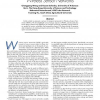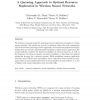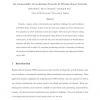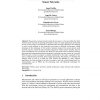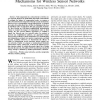NETWORK
2006
13 years 11 months ago
2006
The large-scale deployment of wireless sensor networks (WSNs) and the need for data aggregation necessitate efficient organization of the network topology for the purpose of balan...
NETWORK
2006
13 years 11 months ago
2006
Wireless sensor networks are built upon a shared medium that makes it easy for adversaries to conduct radio interference, or jamming, attacks that effectively cause a denial of se...
NETWORK
2006
13 years 11 months ago
2006
In this article we present a survey of transport protocols for Wireless Sensor Networks (WSNs). We first highlight several unique aspects of WSNs, and describe the basic design cr...
PE
2008
Springer
13 years 11 months ago
2008
Springer
We develop a queueing model for analyzing resource replication strategies in wireless sensor networks. The model can be used to minimize either the total transmission rate of the ...
MONET
2006
13 years 11 months ago
2006
Wireless sensor networks consist of energy-constrained sensor nodes operating unattended in highly dynamic environments. In this paper, we advocate a systematic decentralized appro...
NETWORK
2008
13 years 11 months ago
2008
Realistic, complex, outdoor environments pose significant challenges for node localization in Wireless Sensor Networks. In spite of the fact that many elegant and clever solutions...
JUCS
2006
13 years 11 months ago
2006
: The growth of sensor networks during the last years is a fact and within this field, wireless sensor networks are growing particularly as there are many applications that demand ...
JSAC
2006
13 years 11 months ago
2006
Abstract--Wireless sensor networks have received a lot of attention recently due to its wide applications. An accurate and synchronized clock time is crucial in many sensor network...
JSAC
2006
13 years 11 months ago
2006
Abstract-- Node compromise is a serious threat to wireless sensor networks deployed in unattended and hostile environments. To mitigate the impact of compromised nodes, we propose ...
ENTCS
2007
13 years 11 months ago
2007
In this paper we present an analysis of a MAC (Medium Access Control) protocol for wireless sensor networks. The purpose of this protocol is to manage wireless media access by con...

